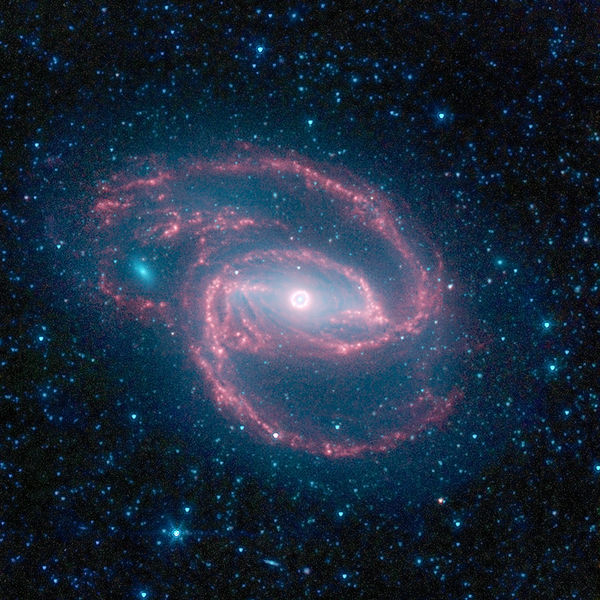|
تضامنًا مع حق الشعب الفلسطيني |
ملف:Coiled Galaxy.jpg

الملف الأصلي (2٬056 × 2٬056 بكسل حجم الملف: 1٫04 ميجابايت، نوع MIME: image/jpeg)
| هذا ملف من ويكيميديا كومنز. معلومات من صفحة وصفه مبينة في الأسفل. كومنز مستودع ملفات ميديا ذو رخصة حرة. |
|
ملخص
| الوصفCoiled Galaxy.jpg |
English: NASA's Spitzer Space Telescope has imaged a wild creature of the dark — a coiled galaxy with an eye-like object at its center.The 'eye' at the center of the galaxy is actually a monstrous black hole surrounded by a ring of stars. In this color-coded infrared view from Spitzer, the area around the invisible black hole is blue and the ring of stars, white.
The galaxy, called NGC 1097 and located 50 million light-years away, is spiral-shaped like our Milky Way, with long, spindly arms of stars. The black hole is huge, about 100 million times the mass of our sun, and is feeding off gas and dust, along with the occasional unlucky star. Our Milky Way's central black hole is tame in comparison, with a mass of a few million suns. The ring around the black hole is bursting with new star formation. An inflow of material toward the central bar of the galaxy is causing the ring to light up with new stars. And, the galaxy's red spiral arms and the swirling spokes seen between the arms show dust heated by newborn stars. Older populations of stars scattered through the galaxy are blue. The fuzzy blue dot to the left, which appears to fit snugly between the arms, is a companion galaxy. Other dots in the picture are either nearby stars in our galaxy, or distant galaxies. This image was taken during Spitzer's cold mission, before it ran out of liquid coolant. The observatory's warm mission is ongoing, with two infrared channels operating at about 30 degrees Kelvin (-406 degrees Fahrenheit). The colors blue, green, and red respectively indicate infrared light of wavelengths 3.6, 4.5, and 8.0 μm (micrometers). The "blue" light has also been subtracted from the "red" in order to enhance the visibility of the dust features. |
| التاريخ | |
| المصدر | |
| المؤلف | NASA/JPL-Caltech |
ترخيص
| Public domainPublic domainfalsefalse |
| يقع هذا العمل في النِّطاق العامّ في الولايات المُتحدة الأمريكيَّة لأَنَّه عملٌ خالِصٌ من إِنتاج وكالة الفضاء الأمريكيَّة. تنصُ حقوق التَّأليف والنَّشر الخاصَّة بوكالة الفضاء الأمريكيَّة على أنَّ "أعمال الوكالة غير مَحميَّة بحقوق التَّأليف والنَّشر ما لم يُذكر خلافُ ذلك". لمزيدٍ من المعلومات انظر القالِب {{PD-USGov}} وصفحة حقوق التَّأليف والنَّشر الخاصَّة بالوكالة وصفحة سياسة الصُّور الخاصَّة بمُختبر الدَّفع النَّفَّاث. |  | |
 |
تنبيهات:
|
الشروحات
العناصر المصورة في هذا الملف
يُصوِّر
٢٣ يوليو 2009
image/jpeg
80b17929ae64c1ec25e75b77827f3613992a2162
١٬٠٩٣٬١٦٤ بايت
٢٬٠٥٦ بكسل
٢٬٠٥٦ بكسل
تاريخ الملف
اضغط على زمن/تاريخ لرؤية الملف كما بدا في هذا الزمن.
| زمن/تاريخ | صورة مصغرة | الأبعاد | مستخدم | تعليق | |
|---|---|---|---|---|---|
| حالي | 03:20، 25 مايو 2010 |  | 2٬056 × 2٬056 (1٫04 ميجابايت) | commonswiki>Tryphon | Better quality, from http://www.spitzer.caltech.edu/Media/releases/ssc2009-14/ssc2009-14a.shtml (http://ipac.jpl.nasa.gov/media_images/ssc2009-14a1.jpg). |
استخدام الملف
ال1 ملف التالي مكررات لهذا الملف (المزيد من التفاصيل):
- ملف:Coiled Galaxy.jpg من ويكيميديا كومنز
الصفحتان التاليتان تستخدمان هذا الملف:
بيانات وصفية
هذا الملف يحتوي على معلومات إضافية، غالبا ما تكون أضيفت من قبل الكاميرا الرقمية أو الماسح الضوئي المستخدم في إنشاء الملف.
إذا كان الملف قد عدل عن حالته الأصلية، فبعض التفاصيل قد لا تعبر عن الملف المعدل.
| عنوان الصورة | NASA's Spitzer Space Telescope has imaged a wild creature of the dark -- a coiled galaxy with an eye-like object at its center.
The galaxy, called NGC 1097, is located 50 million light-years away. It is spiral-shaped like our Milky Way, with long, spindly arms of stars. The "eye" at the center of the galaxy is actually a monstrous black hole surrounded by a ring of stars. In this color-coded infrared view from Spitzer, the area around the invisible black hole is blue and the ring of stars, white. The black hole is huge, about 100 million times the mass of our sun, and is feeding off gas and dust along with the occasional unlucky star. Our Milky Way's central black hole is tame in comparison, with a mass of a few million suns. The ring around the black hole is bursting with new star formation. An inflow of material toward the central bar of the galaxy is causing the ring to light up with new stars. The galaxy's red spiral arms and the swirling spokes seen between the arms show dust heated by newborn stars. Older populations of stars scattered through the galaxy are blue. The fuzzy blue dot to the left, which appears to fit snuggly between the arms, is a companion galaxy. Astronomers say it is unclear whether this companion poked a hole in the larger galaxy, or just happens to be aligned in a gap in the arms. Other dots in the picture are either nearby stars in our galaxy, or distant galaxies. This image was taken during Spitzer's cold mission, before it ran out of liquid coolant. The observatory's warm mission is ongoing, with two infrared channels operating at about 30 Kelvin (minus 406 degrees Fahrenheit). Infrared light with a wavelength of 3.6 microns is blue; 4.5-micron light is green and 8.0-micron light is red. The contribution from starlight measured at 3.6 microns has been subtracted from the 8.0-micron image to enhance the visibility of the dust features. |
|---|---|
| العرض | 2٬056 بك |
| الارتفاع | 2٬056 بك |
| نظام الضغط | إل زد دبليو |
| تركيب البكسل | آر جي بي |
| التوجيه | عادي |
| عدد المكونات | 3 |
| الدقة الأفقية | 72 نقطة لكل بوصة |
| الدقة الرأسية | 72 نقطة لكل بوصة |
| ترتيب البيانات | صيغة مكتنزة |
| البرمجيات المستخدمة | Adobe Photoshop CS3 Macintosh |
| تاريخ ووقت تغيير الملف | 16:54، 22 يوليو 2009 |
| الفضاء اللوني | غير معاير |